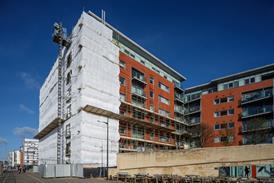Recent Construction and Development
-
 Feature
FeatureAfter Grenfell
Phase 2 of the Grenfell inquiry report was published in September. Ian Quayle considers its implications for property practitioners
-
 Feature
FeatureSafety first
The Building Safety Act is evolving as it is brought into force. Mark Roach and Harriet Hawkins explore the latest developments
-
 Feature
FeatureA private function
In February 2023, the Supreme Court held that visual intrusion by the viewing gallery in the Tate Modern’s Blavatnik Building was a private nuisance against those living in a nearby block of flats. Joanna Williams and Joseph Skilton consider the impact of the verdict
-
 Feature
FeatureHeightened risk
New obligations around ‘higher-risk’ buildings will come into force this year. Becky Johnson looks at what this will mean when advising clients
-
 Feature
FeatureWalking in the air
Simon Kenneally looks at airspace development and outlines what lawyers and developers need to know to advise clients
-
 Feature
FeatureMine of information
David Manda and Claire Acklam offer legal and practical advice on how mines and minerals rights may impact on or interfere with the development of land
-
 Feature
FeatureFire safety update
John Baguley, who oversaw the introduction of the EWS1 form and process, explains how the process works in practice, and what might change next around fire safety and cladding
-
 Feature
FeatureOn the safe side
Phil Parkinson and Katie Edwards review the significant changes around building safety in the last year, including new legislation, the impact of the pandemic, and what might happen in the year ahead
-
 Feature
FeatureAt your service
In the third in his series on what property solicitors need to know about different phases of the development process, Gavin Le Chat looks at drainage and the supply of services
-
 Feature
FeatureWhat’s new?
How should you advise clients buying new-build properties? John Wallace provides the construction lawyer’s perspective
-
 Feature
FeatureAccess all areas?
In the second in his series on what property solicitors need to know about different phases of the development process, Gavin Le Chat looks at potential access issues
-
 Feature
FeatureKey to success
Richard Snape looks at some of the ways restrictive covenants can be challenged and discharged, in order to free up land for development or for a change of use
-
 Feature
FeatureChapter and reverse
The construction VAT reverse charge comes into force this October. Ronan Lowney and Michelle Essen explain the changes and what those involved in construction and development need to do next
-
 Feature
FeatureOn the right foot
In the first in a series on what property solicitors need to know about different phases of the development process, Gavin Le Chat looks at the importance of a site inspection and other preliminary investigations
-
 Feature
FeatureBuilding in safety
Simon Lewis looks at developments on building safety following the Hackitt review and the Ministry of Housing, Communities & Local Government’s consultation paper, Building a safer future: proposals for reform of the building safety regulatory system
-
 News
NewsDo you think there should be a specific CON29DW for new-build properties?
The Drainage and Water Searches Network (DWSN) is currently undertaking an informal consultation to seek conveyancers’ views on the development of a specific CON29DW for new-build properties
-
 Feature
FeatureBrick by brick
Self- and custom-build are becoming increasingly common. Charlie Blagbrough argues that this development could reinject diversity into house building and supply, and explains how the lending process works in this market
-
 Opinion
OpinionCleaning house
The government has turned its eye to change in the residential housing sector, from ensuring sufficient supply, to addressing escalating ground rents. Warren Gordon explains
-
 Feature
FeatureDevolution evolution
Michael Draper outlines some of the unique law – both existing and on the horizon – in Wales, as it relates to property, including potential new developments around vacant sites and residential lettings
-
 Feature
FeatureForgive and forget
Certificates of lawful development provide a way for property owners to prove the lawfulness of unauthorised development, after a certain period of time has passed. Anna Russell-Knee explains how they work in practice














